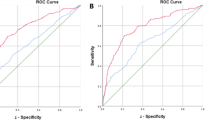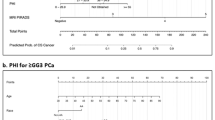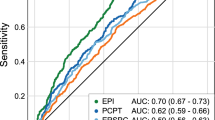Abstract
Background:
Men with persistently elevated and/or rising PSA levels after negative prostate biopsy often undergo multiple repeat biopsies. Prostate cancer antigen 3 (PCA3) has emerged as a predictor of prostate cancer.
Methods:
We sought to define the utility of PCA3 in combination with other clinical data in predicting the risk of prostate cancer on repeat biopsy. We retrospectively obtained PCA3, PSA, PSA density (PSAD), digital rectal examination (DRE) and transrectal ultrasound (TRUS) findings from 103 patients at a single institution who had at least one prior negative prostate biopsy. The sensitivity and specificity of PCA3 in detecting prostate cancer was determined. Receiver operating characteristics curves were produced for each variable individually and in multivariable analysis, controlling for PCA3, PSAD, TRUS, PSA and DRE. A nomogram was created, internally validated and compared to another recently published nomogram.
Results:
Of the 103 patients, 37 (31%) had prostate cancer on repeat biopsy. The sensitivity and specificity of PCA3 (using a cut point of 25) was 0.67 and 0.64, respectively. In multivariable analyses, PCA3 was independently associated with prostate cancer (odds ratio: 1.02, 95% confidence interval: 1.01–1.04), with area under the curve (AUC) of 0.64. A multivariable model containing PCA3, PSAD, PSA, DRE and TRUS findings showed the most diagnostic accuracy (AUC: 0.82).
Conclusions:
In the setting of prior negative biopsies, PCA3 was independently associated with prostate cancer in a multivariable model. In combination with other clinical data, PCA3 is a valuable tool in assessing the risk of prostate cancer on repeat biopsy.
This is a preview of subscription content, access via your institution
Access options
Subscribe to this journal
Receive 4 print issues and online access
$259.00 per year
only $64.75 per issue
Buy this article
- Purchase on Springer Link
- Instant access to full article PDF
Prices may be subject to local taxes which are calculated during checkout





Similar content being viewed by others
References
Raja J, Ramachandran N, Munneke G, Patel U . Current status of transrectal ultrasound-guided prostate biopsy in the diagnosis of prostate cancer. Clin Radiol 2006; 61: 142.
Presti Jr JC . Repeat prostate biopsy—when, where, and how. Urol Oncol 2009; 27: 312.
Fujita K, Landis P, McNeil BK, Pavlovich CP . Serial prostate biopsies are associated with an increased risk of erectile dysfunction in men with prostate cancer on active surveillance. J Urol 2009; 182: 2664.
Nam RK, Saskin R, Lee Y, Liu Y, Law C, Klotz LH et al. Increasing hospital admission rates for urological complications after transrectal ultrasound guided prostate biopsy. J Urol 2010; 183: 963.
Djavan B, Ravery V, Zlotta A, Dobronski P, Dobrovits M, Fakhari M et al. Prospective evaluation of prostate cancer detected on biopsies 1, 2, 3 and 4: when should we stop? J Urol 2001; 166: 1679.
Hessels D, Klein Gunnewiek JM, van Oort I, Karthaus HF, van Leenders GJ, van Balken B et al. DD3(PCA3)-based molecular urine analysis for the diagnosis of prostate cancer. Eur Urol 2003; 44: 8.
Deras IL, Aubin SM, Blase A, Day JR, Koo S, Partin AW et al. PCA3: a molecular urine assay for predicting prostate biopsy outcome. J Urol 2008; 179: 1587.
Marks LS, Fradet Y, Deras IL, Blase A, Mathis J, Aubin SM et al. PCA3 molecular urine assay for prostate cancer in men undergoing repeat biopsy. Urology 2007; 69: 532.
Haese A, de la Taille A, van Poppel H, Marberger M, Stenzl A, Mulders PF et al. Clinical utility of the PCA3 urine assay in European men scheduled for repeat biopsy. Eur Urol 2008; 54: 1081.
Chun FK, de la Taille A, van Poppel H, Marberger M, Stenzl A, Mulders PF et al. Prostate cancer gene 3 (PCA3): development and internal validation of a novel biopsy nomogram. Eur Urol 2009; 56: 659.
Vickers AJ, Elkin EB . Decision curve analysis: a novel method for evaluating prediction models. Med Decis Making 2006; 26: 565.
Flanigan RC, Catalona WJ, Richie JP, Ahmann FR, Hudson MA, Scardino PT et al. Accuracy of digital rectal examination and transrectal ultrasonography in localizing prostate cancer. J Urol 1994; 152: 1506.
O’Dowd GJ, Miller MC, Orozco R, Veltri RW . Analysis of repeated biopsy results within 1 year after a noncancer diagnosis. Urology 2000; 55: 553.
Chun FK, Briganti A, Graefen M, Porter C, Montorsi F, Haese A et al. Development and external validation of an extended repeat biopsy nomogram. J Urol 2007; 177: 510.
Ankerst DP, Groskopf J, Day JR, Blase A, Rittenhouse H, Pollock BH et al. Predicting prostate cancer risk through incorporation of prostate cancer gene 3. J Urol 2008; 180: 1303.
Aubin SM, Reid J, Sarno MJ, Blase A, Aussie J, Rittenhouse H et al. PCA3 molecular urine test for predicting repeat prostate biopsy outcome in populations at risk: validation in the placebo arm of the dutasteride REDUCE trial. J Urol 2010; 184: 1947–1952.
Perdona S, Cavadas V, Di Lorenzo G, Damiano R, Chiappetta G, Del Prete P et al. Prostate cancer detection in the ‘grey area’ of prostate-specific antigen below 10 ng/ml: head-to-head comparison of the updated PCPT calculator and Chun's nomogram, two risk estimators incorporating prostate cancer antigen 3. Eur Urol 2011; 59: 81.
Auprich M, Haese A, Walz J, Pummer K, de la Taille A, Graefen M et al. External validation of urinary PCA3-based nomograms to individually predict prostate biopsy outcome. Eur Urol 2010; 58: 727.
Catalona WJ, Smith DS, Wolfert RL, Wang TJ, Rittenhouse HG, Ratliff TL et al. Evaluation of percentage of free serum prostate-specific antigen to improve specificity of prostate cancer screening. JAMA 1995; 274: 1214.
Djavan B, Zlotta A, Remzi M, Ghawidel K, Basharkhah A, Schulman CC et al. Optimal predictors of prostate cancer on repeat prostate biopsy: a prospective study of 1051 men. J Urol 2000; 163: 1144.
Carter HB . Pearson JD. PSA velocity for the diagnosis of early prostate cancer. A new concept. Urol Clin North Am 1993; 20: 665.
Djavan B, Zlotta A, Kratzik C, Remzi M, Seitz C, Schulman CC et al. PSA, PSA density, PSA density of transition zone, free/total PSA ratio, and PSA velocity for early detection of prostate cancer in men with serum PSA 2.5–4.0 ng/ml. Urology 1999; 54: 517.
Author information
Authors and Affiliations
Corresponding author
Ethics declarations
Competing interests
The authors declare no conflict of interest.
Rights and permissions
About this article
Cite this article
Wu, A., Reese, A., Cooperberg, M. et al. Utility of PCA3 in patients undergoing repeat biopsy for prostate cancer. Prostate Cancer Prostatic Dis 15, 100–105 (2012). https://doi.org/10.1038/pcan.2011.52
Received:
Revised:
Accepted:
Published:
Issue Date:
DOI: https://doi.org/10.1038/pcan.2011.52



